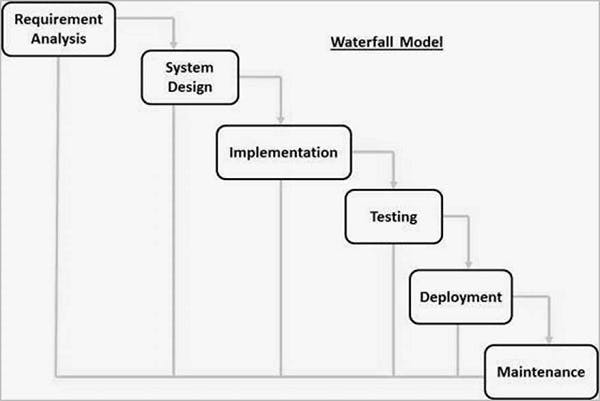The Waterfall Model was the first Process Model to be introduced. It is also referred to as a linear-sequential life cycle model. It is very simple to understand and use. In a waterfall model, each phase must be completed before the next phase can begin and there is no overlapping in the phases.
Waterfall Model - Design
In "The Waterfall" approach, the whole process of software development is divided into separate phases. In this Waterfall model, typically, the outcome of one phase acts as the input for the next phase sequentially.

The sequential phases are -
Requirement Gathering and analysis - All possible requirements of the system to be developed are captured in this phase and documented in a requirement specification document.
System Design - The requirement specifications from the first phase are studied in this phase and the system design is prepared. This system design helps in specifying hardware and system requirements and helps in defining the overall system architecture.
Implementation: With inputs from the system design, the system is first developed in small programs called units, which are integrated in the next phase. Each unit is developed and tested for its functionality, which is referred to as Unit Testing.
Integration and Testing: All the units developed in the implementation phase are integrated into a system after testing each unit. Post integration the entire system is tested for any faults and failures.
Deployment of system: There are some issues that come up in the client environment. To fix those issues, patches are released. Also to enhance the product some better versions are released. Maintenance is done to deliver these changes in the customer environment.
Waterfall Model - Application
Some situations where the use of Waterfall model is most appropriate is -
Requirements are very well documented, clear and fixed
Product definition is stable
Technology is understood and is not dynamic
There are no ambiguous requirements
Ample resources with required expertise are available to support the product.
The project is short.
Waterfall Model - Advantages
Simple and easy to understand and use
Easy to manage due to the rigidity of the model, Each phase has specific deliverables and a review process.
Phases are processed and completed one at a time
Works well for smaller projects where requirements are very well understood
Clearly defined stages
Well understood milestones
Easy to arrange tasks
Process and results are well documented.
Waterfall Model - Disadvantages
The major disadvantages are -
No working software is produced until late during the life cycle
High amounts of risk and uncertainty
Not a good model for complex and object-oriented projects.
Poor model for long and ongoing projects
Not suitable for projects where requirements are at a moderate to high risk of changing. So, risk and uncertainty is high with this process model.
It is difficult to measure progress within stages.
Cannot accommodate changing requirements
Adjusting scope during the life cycle can end a project
Integration is done as big bang at the very end, which doesn't allow identifying any technological or business bottleneck or challenges early.

